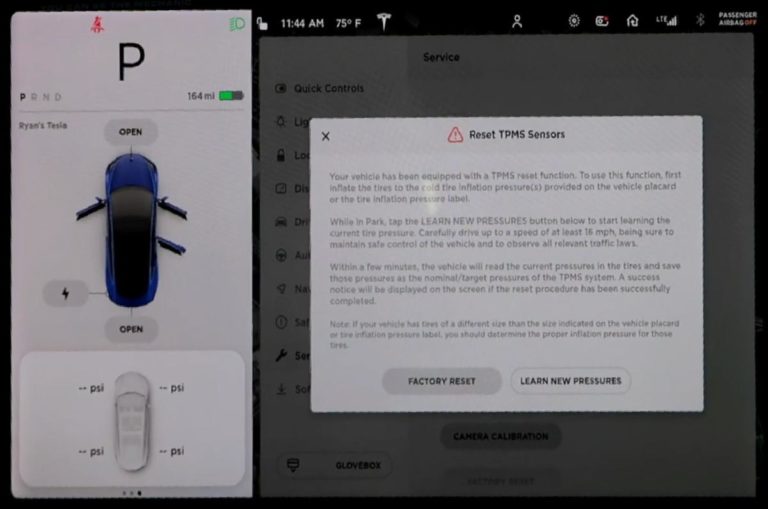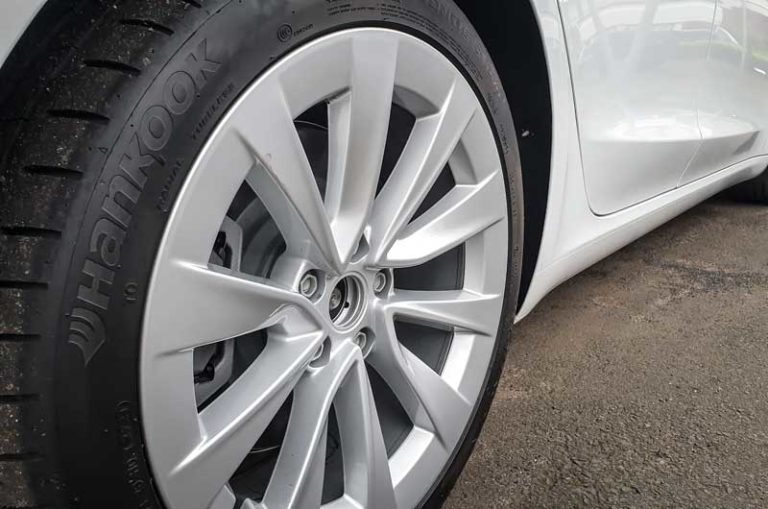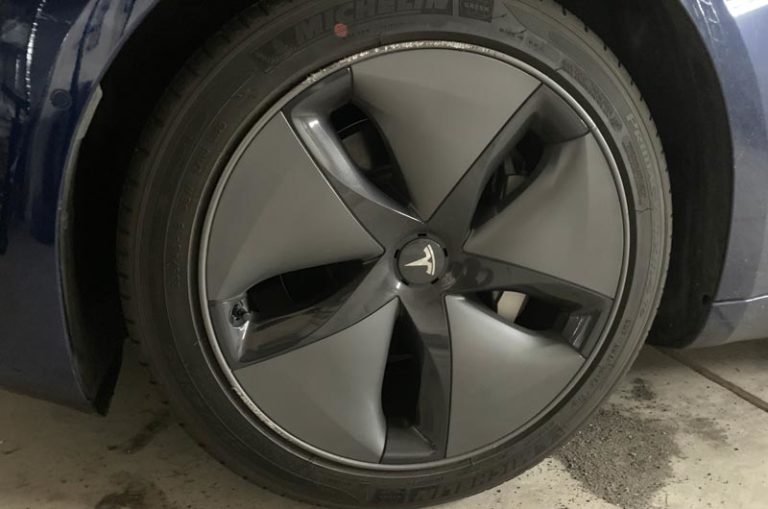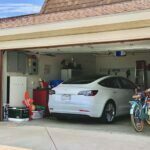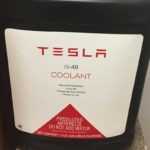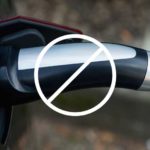Teslas are beloved for their high-tech features, sleek designs, and top-notch electric components. One of the most popular features included with these cars is the ability to check tire pressure using the internal display screen. But how do you enable this feature?
Here’s how to display tire pressure on the Tesla Model 3:
- Turn the vehicle on.
- Swipe left near the microphone symbol on the screen.
This guide will discuss how to check the tire pressure on a Tesla Model 3 in more detail. It will also explain how to check the tire pressure for the other Tesla models (Model X, Model Y and Model S).
- How To Check Tire Pressure: Tesla Model 3
- How Do You Check Tire Pressure on a Tesla Car? Other Models
- How To Check the Tesla Model S Tire Pressure
- What is Tesla TPMS?
- Understanding the Tire Pressure Monitoring System (TPMS)
- Interpreting Tire Pressure Readings
- How Do You Pump Up a Tesla Tire?
- Related questions you might have!
- Why Tire Pressure Matters for Tesla Cars
- Adjusting Tire Pressure in Extreme Weather
- Maintaining Proper Tire Pressure
- How Often Should I Check the Tire Pressure on my Tesla Model 3?
- Can I Rely Solely on the TPMS for Checking Tire Pressure Or Should I Still Use a Gauge?
- How Does Tire Air Pressure Affect The Range of a Tesla car?
- Should I Get Winter Tires for My Tesla?
- Should I use Tire Chains on my Tesla?
How To Check Tire Pressure: Tesla Model 3
1. Turn the Vehicle On
To see the tire pressure display, you need to turn the car on. Then, once the vehicle is on, you’ll need to wait a few minutes to give the car a chance to check the pressure. This is one of many routine checks your Tesla will perform each time you turn the car on, so it may take a few minutes.
Also, keep in mind that it may not display any numbers. This is likely to happen if the car has been stationary for a while. To get the readings, you’ll need to drive around and allow the vehicle to make its internal checks.

2. Swipe Left Near the Microphone Symbol on the Screen
Once your Tesla is on and activated, you’ll notice the display screen in the middle has two distinct sides. On the right-hand side, you’ll see options such as:
- Quick controls
- Lights
- Locks
- Autopilot
- Navigation
On the left side of the screen, you’ll see a small image of a Tesla, under which there should be three symbols. This is where the tire pressure will be displayed. Tap and hold the screen near the microphone symbol (on the right) and swipe to the left.
The display will change, showing you an enlarged image of your Tesla along with PSI readings of each tire.
Watch this video for a visual demonstration of how to check the tire pressure on a Tesla Model 3:
How Do You Check Tire Pressure on a Tesla Car? Other Models
Checking your Tesla’s tire pressure is a straightforward process but differs slightly depending on the type of Tesla model you own. We’ve already covered how to check it on a Tesla Model 3. It’s a slightly different process on newer vehicles.
As such, let’s delve into checking the tire pressure of the three other current Tesla models.
| Model Type | Tesla Model 3 | Tesla Model S | Tesla Model X | Tesla Model Y |
| Where tire pressure is displayed | Center console | Driver dashboard | Driver dashboard | Center console |
Tesla Model 3 and Tesla Model Y
Checking the tire pressure on your Model Y is as straightforward as it was for the Model 3. First, you’ll need to enter your vehicle and turn it on. Then, access the digital display screen to the right of the steering wheel.
From here, you’ll want to pay attention to the left portion of the screen, the portion showing a digital visualization of your vehicle. Make a swipe motion (from the right side to the left) to bring up your vehicle’s current tire pressure. You’ll see the three symbols move and be replaced by a large image of the car with the PSI information clearly visible.
Are Tesla Tires run-on-flat? I explored this question in detail. Have a look.
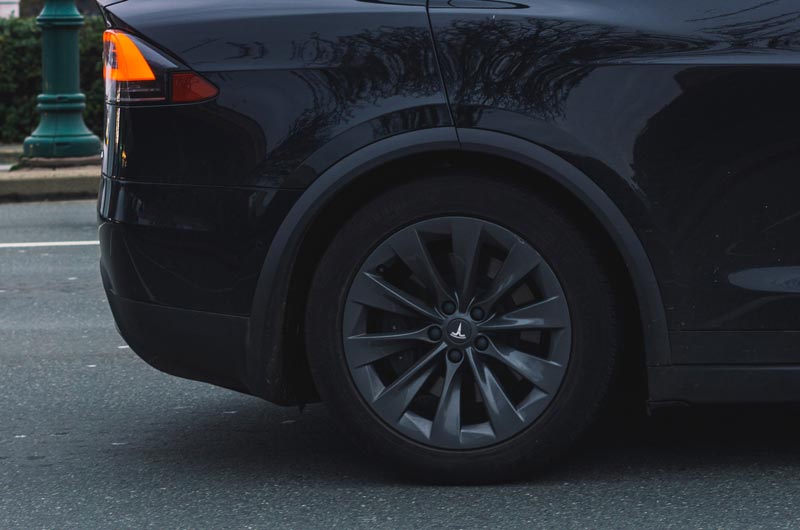
There’s not much difference between checking the tire pressure of a Tesla Model Y and that of a Tesla Model 3.
You can also measure the tire pressure manually.
Here’s how to manually check the tire pressure on a Tesla Model Y:
- Read the label on the driver’s door pillar.
- Detach the valve cap.
- Push an accurate gauge onto the valve.
- Read the pressure off the gauge.
How to Check Your Tesla Model X Tire Pressure
To check the tire pressure of a Model X , you’ll need to utilize the right-hand-side click wheel (located in your steering wheel) to access the digital dashboard’s menus.
To do this, press and hold the click wheel for a few seconds, then move it up or down to scroll. You’ll see this movement displayed on the screen behind the wheel, not the console in the middle like in the Model 3.
View your digital dashboard while scrolling to find the ‘Car Status’ menu. Press the click wheel down to select this menu and view tire pressure. Remember, your vehicle won’t show this information if it’s currently in park mode.
Also, try the following when checking your Tesla’s tire pressure:
- Drive your Model X for about 1 mile (1.6 Kilometers). This allows the car’s computer to read the tire pressure accurately. Driving at a high speed isn’t necessary; normal speeds will suffice.
- Press the left scroll wheel down. Scroll down using the left wheel control until a scrollable menu is displayed on-screen. The menu will have various options, including “Check Status/Car Status.”
- Press the left wheel control once to select the “Tires” option. This will bring up a detailed view of your car’s tires, including their pressure and status.
If the tire pressure is low, add air until it reaches the recommended pressure on your car’s tire and loading information label.
How To Check the Tesla Model S Tire Pressure
Another popular Tesla model is the Tesla Model S. Follow the same steps to check the tire pressure on a Model S as you would on a Model X.
Here’s how to check the tire pressure on a Tesla Model S:
- Drive your Tesla Model S for about 1 mile (1.6 km).
- Press the scroll wheel down.
- Scroll down to “Check Status” using the left wheel control.
You can use this online Tesla tire calculator to find how long any Tesla Model tire will last. You can also estimate the number of miles left on your current set and how many days you have until they need to be swapped out for new ones. If that is the case, you can also find the price for any set of Tesla tires by selecting the appropriate tires. Have fun!
What is Tesla TPMS?
Having your tires either over or under-inflated can cause some serious problems, like decreased range and even potential blowouts. This is why it’s crucial to keep a close eye on your tire pressure, especially in a Tesla Model car.
Luckily, Tesla cars come equipped with a tire pressure monitoring system (TPMS) that constantly checks the pressure in all four tires. If any of them are too low or too high, you’ll receive a warning icon on your dashboard.
Understanding the Tire Pressure Monitoring System (TPMS)
You’ll love learning about how your Tesla Model keeps track of the air inside your wheels through its tire pressure monitoring system (TPMS). This feature helps you stay safe and comfortable on the road by alerting you when your tires are underinflated or overinflated.
The TPMS is a small computer that uses sensors located in each wheel to measure the air pressure. The TPMS sends information to the car’s main computer, which then displays the tire pressure on your dashboard.
If there is a problem with any of your tires, such as low pressure, you will receive an alert on your display screen. This feature ensures that you can always keep an eye on your tire pressure and avoid potential problems while driving.
Overall, it’s essential to understand how the tire pressure monitor works so you can maintain proper inflation levels and prevent accidents on the road.
Interpreting Tire Pressure Readings
Now that you know how your Tesla Model keeps your wheels in check with the tire pressure monitor, let’s dive into making sense of those numbers on your dashboard.
The first thing to understand is what each number represents. Your Tesla will display the air pressure for each tire individually, usually in pounds per square inch (PSI).
It’s important to note that the recommended PSI for your tires can vary depending on a few factors such as temperature and load capacity. The optimal air pressure range for your specific vehicle should be listed in your owner’s manual or on a sticker located inside the driver-side doorjamb.
How Do You Pump Up a Tesla Tire?
If you’re running on underinflated tires, it’s crucial to fill them with air as soon as possible. If you drive with underinflated tires for too long, you risk causing an accident or damaging your tires.
Here’s how to pump up a Tesla tire:
- Attach a pressure gauge to the valve stem.
- Use a foot pump to inflate the tire to the proper pressure.
- Remove the gauge from the valve stem.
- Reattach the valve cap to its stem.
Here’s a 2-minute video that demonstrates these steps:
Note: If you don’t have a foot pump, you can use an air compressor with a pressure gauge attached. For the best results, ensure the tire pressure reaches the recommended number on your car’s tire and the loading information label.
| Tesla Model | Recommended Pressure |
| Model 3 | 45 PSI (310 kPa) |
| Model Y | 42 PSI (290 kPa) |
| Model S | 40 PSI (276 kPa) |
| Model X | 42 PSI (290 kPa) |
Related questions you might have!
Can You Put Any Tire on a Tesla?
The most important consideration is size and tire pressure. That said, it’s also worthwhile to consider tire type (all-terrain, all-season, snow, sand, etc.) to ensure your tires enjoy a long life. Tesla’s come with top-of-the-line tires, so it’s recommended that you replace them with the same.
Why Do Tesla Tires Have Foam in Them?
Why Tire Pressure Matters for Tesla Cars
Correct tire pressure affects many aspects of your driving, including fuel efficiency, handling, braking distance, and overall comfort.
With Teslas being high-performance vehicles that rely heavily on their battery range and instant torque capabilities, maintaining adequate tire pressure is even more crucial.
What Happens if the Tire Pressure is Too Low or Too High?
If your Tesla’s tire pressure is too low, you’ll experience decreased fuel efficiency (or range in the case of electric vehicles) and increased wear and tear on your tires. This can also lead to poor handling and reduced safety while driving.
On the other hand, if the tire pressure is too high, you risk a blowout or uneven wear on your tires. This could result in costly repairs and potential accidents.
Adjusting Tire Pressure in Extreme Weather
When extreme weather hits, it’s important to ensure your tires are properly inflated so that they can grip the slippery roads and keep you safe as you cruise down the highway.
In cold weather, it’s common for tire pressure to drop due to contraction of air molecules. This means that during winter months, you may need to increase your tire pressure slightly above what is recommended in order to compensate for this natural phenomenon.
Additionally, it’s important to consider using winter tires designed specifically for colder temperatures and icy conditions. This is discussed in more detail below.
Maintaining Proper Tire Pressure
Properly maintaining the inflation levels of your vehicle’s tires is crucial for safe and efficient driving, especially during extreme weather conditions.
To maintain proper tire pressure in your Tesla Model, it’s recommended that you check the levels at least once a month or before embarking on a long journey. You can do this manually with a handheld gauge or use the car’s technology to display it on the dashboard.
Keeping your tires inflated to the manufacturer-recommended level also helps extend their lifespan and improves overall performance. Plus, it contributes to reducing greenhouse gas emissions by minimizing energy consumption while driving.
So make sure to prioritize maintaining proper tire pressure as part of your routine vehicle maintenance!
How Often Should I Check the Tire Pressure on my Tesla Model 3?
Make sure to check your Model 3’s tires at least once a month or before long drives to ensure they’re properly inflated for safe and efficient driving.
However, your Tesla Model 3 comes equipped with a tire pressure monitor that alerts you when the pressure drops below the recommended level. So even if you forget to check your tire pressure, your vehicle will alert you if there is a problem.
The recommended tire pressure for the Tesla Model 3 is typically around 42 psi for both front and rear tires.
Can I Rely Solely on the TPMS for Checking Tire Pressure Or Should I Still Use a Gauge?
Relying solely on the tire pressure monitoring system (TPMS) may not be sufficient for ensuring optimal driving performance and preventing potential damage to your Tesla Model. While the TPMS can provide valuable information about the tire pressure, it’s not infallible.
It’s important to note that the TPMS only alerts you when a tire is significantly under-inflated or over-inflated; it doesn’t measure the actual pressure in each tire.
To ensure that your tires are properly inflated, it’s recommended that you physically check them at least once a month, especially before long trips. You can use a tire gauge to accurately measure each tire’s pressure, which should match the recommended psi range specified in your Tesla owner’s manual.
By checking your tires regularly, you can detect any slow leaks or other issues that might cause problems while driving.
How Does Tire Air Pressure Affect The Range of a Tesla car?
Underinflated tires cause more friction on the road surface than properly inflated ones, meaning they require more energy from the battery pack to power through.
In other words, if your car has low tire pressure, it will consume more electricity and reduce range.
Conversely, over-inflated tires can lead to decreased traction and uneven wear patterns that may require replacing them sooner than expected.
Should I Get Winter Tires for My Tesla?
Winter driving can be unpredictable, so it’s important to consider investing in winter tires for your Tesla.
Winter weather often leads to slippery roads and reduced visibility, which means that having the right set of tires can make all the difference. Investing in winter tires for your Tesla can provide extra grip and traction on icy or snowy roads.
These specialized tires have deeper treads and softer rubber compounds than all-season ones, which helps them maintain their flexibility even in colder temperatures.
Keep in mind that while winter tires may seem like an unnecessary expense, they may end up saving you money in the long run by reducing wear and tear on your regular set of tires.
Plus, they’ll give you peace of mind knowing that you’re better equipped to handle whatever winter weather comes your way.
Should I use Tire Chains on my Tesla?
Don’t get caught unprepared in the middle of a winter storm; consider using tire chains on your Tesla to provide extra traction and safety on the most treacherous roads.
While it’s true that some Teslas come with all-wheel drive, which can handle slippery conditions pretty well, adding tire chains to your vehicle will make sure you have maximum grip on icy or snowy roads.
However, be aware that not all Tesla models’ tires are compatible with tire chains, so check with your manual before making any purchases. Another key thing to remember is that adding tire chains may affect your Tesla’s tire pressure monitor.
I recommend only using tire chains if you live in an area where the winter gets really hectic!
Check out these 20 great gift ideas for yourself or a Tesla fanboy.
Contact Us if you have any questions or queries.


